Operational Management Project Report for Woolworths
VerifiedAdded on 2023/01/19
|30
|5576
|80
Report
AI Summary
This report delves into the intricacies of operational management, presenting a comprehensive analysis and practical application of operational planning principles within the context of a retail business, specifically Woolworths. The report is divided into two main parts: Part A focuses on knowledge evidence, exploring various models and methods used for organizational operational plans, key elements of such plans, approaches to developing key performance indicators (KPIs), the role of operational plans in meeting organizational objectives, and the steps involved in the budgeting process. Part B transitions to a project-based approach, developing an operational plan for Woolworths. This includes resource requirement analysis, stakeholder consultation, implementation of a consultation process, KPI development, contingency planning, seeking specialist advice, and communication of the operational plan to the relevant work team. Further, the report covers plan and manage resource acquisition, incorporating recruitment strategies aligned with HR policies, strategies to acquire physical resources, and addressing intellectual property rights. The final section focuses on monitoring and reviewing operational performance, including developing and reviewing performance systems, analyzing financial information, identifying and rectifying under-performance, negotiating recommendations for variations, and developing performance documentation and record-keeping systems. The report incorporates real-world application, providing a practical guide to operational management within a retail environment.
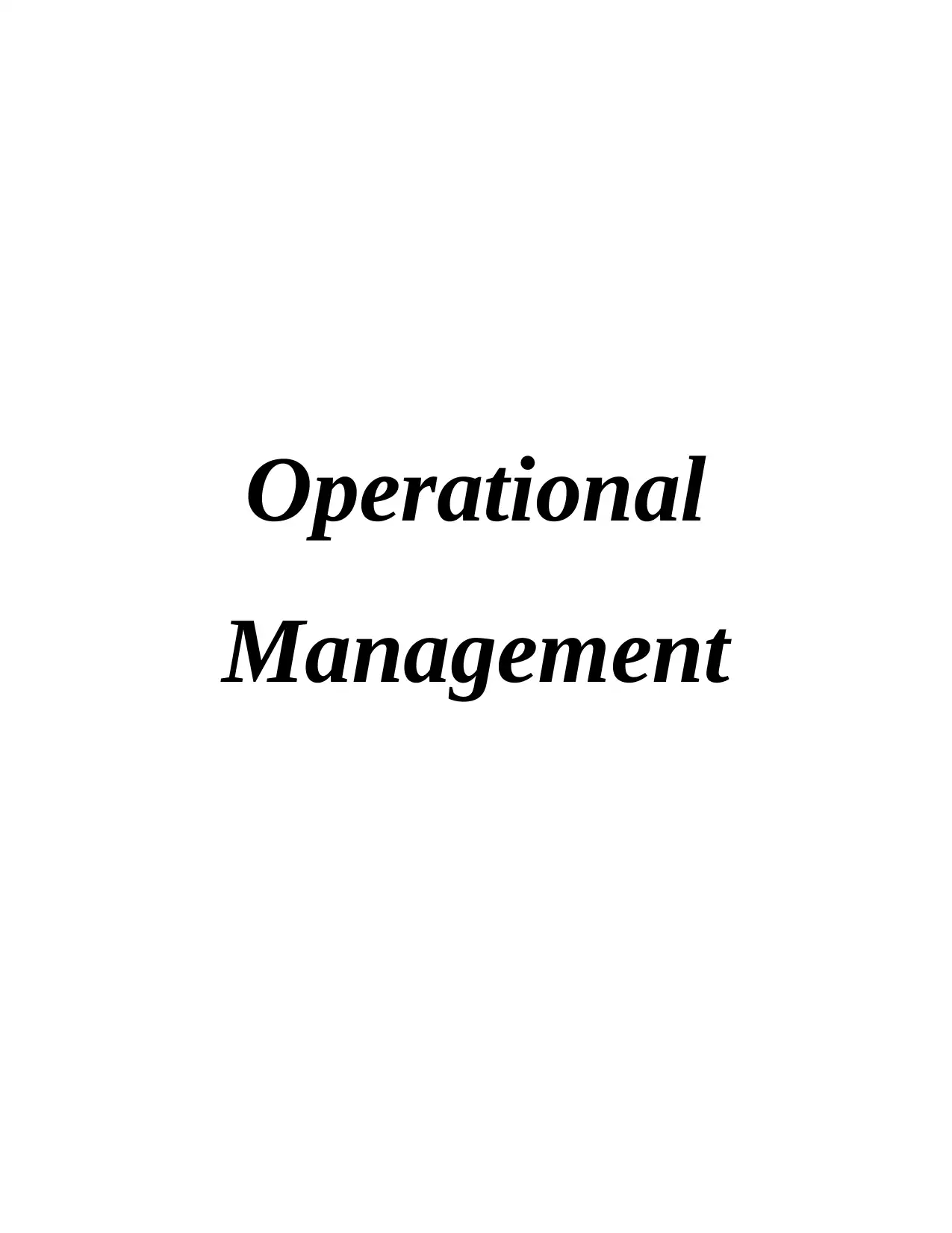
Operational
Management
Management
Paraphrase This Document
Need a fresh take? Get an instant paraphrase of this document with our AI Paraphraser
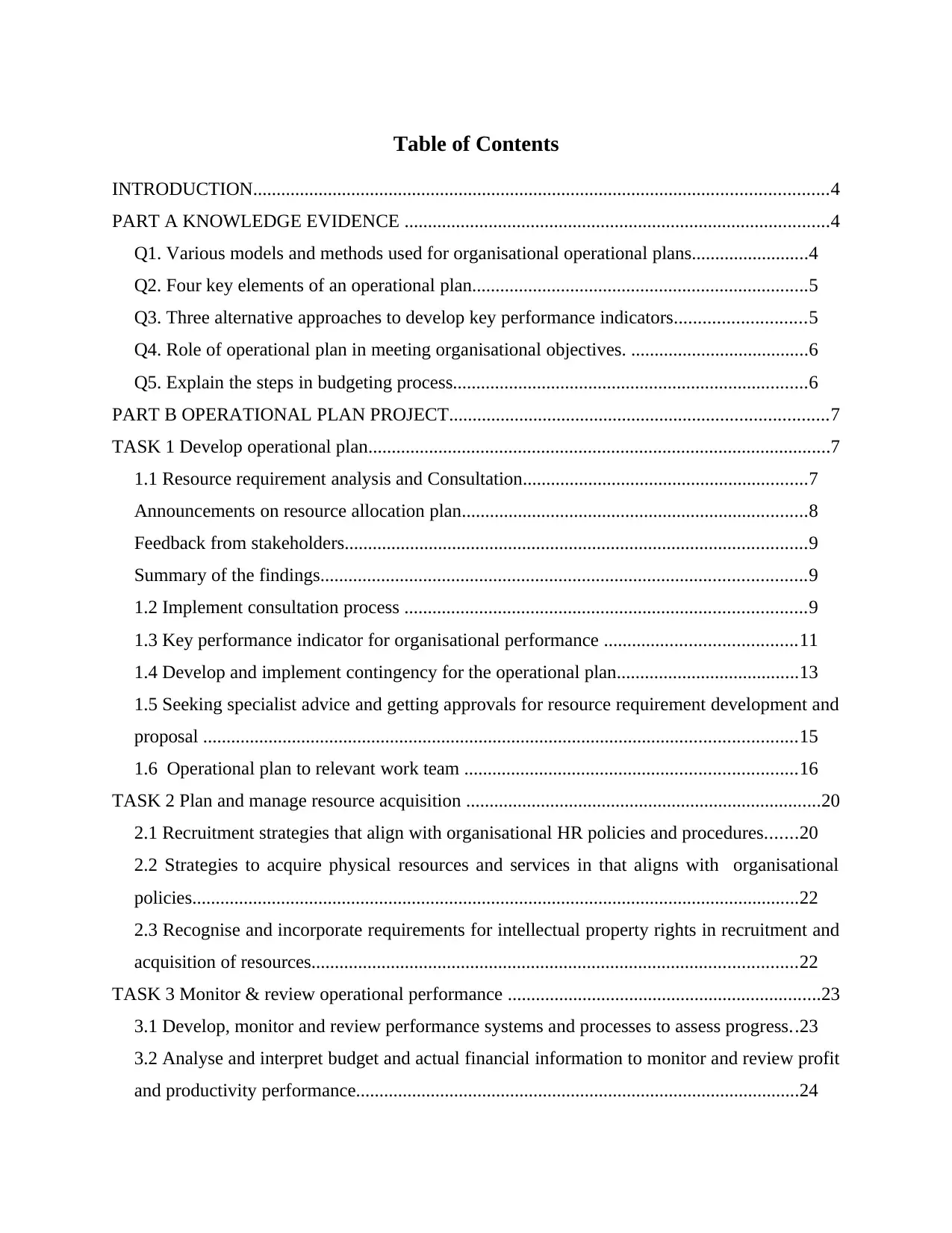
Table of Contents
INTRODUCTION...........................................................................................................................4
PART A KNOWLEDGE EVIDENCE ...........................................................................................4
Q1. Various models and methods used for organisational operational plans.........................4
Q2. Four key elements of an operational plan........................................................................5
Q3. Three alternative approaches to develop key performance indicators............................5
Q4. Role of operational plan in meeting organisational objectives. ......................................6
Q5. Explain the steps in budgeting process............................................................................6
PART B OPERATIONAL PLAN PROJECT.................................................................................7
TASK 1 Develop operational plan...................................................................................................7
1.1 Resource requirement analysis and Consultation.............................................................7
Announcements on resource allocation plan..........................................................................8
Feedback from stakeholders...................................................................................................9
Summary of the findings........................................................................................................9
1.2 Implement consultation process ......................................................................................9
1.3 Key performance indicator for organisational performance .........................................11
1.4 Develop and implement contingency for the operational plan.......................................13
1.5 Seeking specialist advice and getting approvals for resource requirement development and
proposal ...............................................................................................................................15
1.6 Operational plan to relevant work team .......................................................................16
TASK 2 Plan and manage resource acquisition ............................................................................20
2.1 Recruitment strategies that align with organisational HR policies and procedures.......20
2.2 Strategies to acquire physical resources and services in that aligns with organisational
policies..................................................................................................................................22
2.3 Recognise and incorporate requirements for intellectual property rights in recruitment and
acquisition of resources........................................................................................................22
TASK 3 Monitor & review operational performance ...................................................................23
3.1 Develop, monitor and review performance systems and processes to assess progress..23
3.2 Analyse and interpret budget and actual financial information to monitor and review profit
and productivity performance...............................................................................................24
INTRODUCTION...........................................................................................................................4
PART A KNOWLEDGE EVIDENCE ...........................................................................................4
Q1. Various models and methods used for organisational operational plans.........................4
Q2. Four key elements of an operational plan........................................................................5
Q3. Three alternative approaches to develop key performance indicators............................5
Q4. Role of operational plan in meeting organisational objectives. ......................................6
Q5. Explain the steps in budgeting process............................................................................6
PART B OPERATIONAL PLAN PROJECT.................................................................................7
TASK 1 Develop operational plan...................................................................................................7
1.1 Resource requirement analysis and Consultation.............................................................7
Announcements on resource allocation plan..........................................................................8
Feedback from stakeholders...................................................................................................9
Summary of the findings........................................................................................................9
1.2 Implement consultation process ......................................................................................9
1.3 Key performance indicator for organisational performance .........................................11
1.4 Develop and implement contingency for the operational plan.......................................13
1.5 Seeking specialist advice and getting approvals for resource requirement development and
proposal ...............................................................................................................................15
1.6 Operational plan to relevant work team .......................................................................16
TASK 2 Plan and manage resource acquisition ............................................................................20
2.1 Recruitment strategies that align with organisational HR policies and procedures.......20
2.2 Strategies to acquire physical resources and services in that aligns with organisational
policies..................................................................................................................................22
2.3 Recognise and incorporate requirements for intellectual property rights in recruitment and
acquisition of resources........................................................................................................22
TASK 3 Monitor & review operational performance ...................................................................23
3.1 Develop, monitor and review performance systems and processes to assess progress..23
3.2 Analyse and interpret budget and actual financial information to monitor and review profit
and productivity performance...............................................................................................24
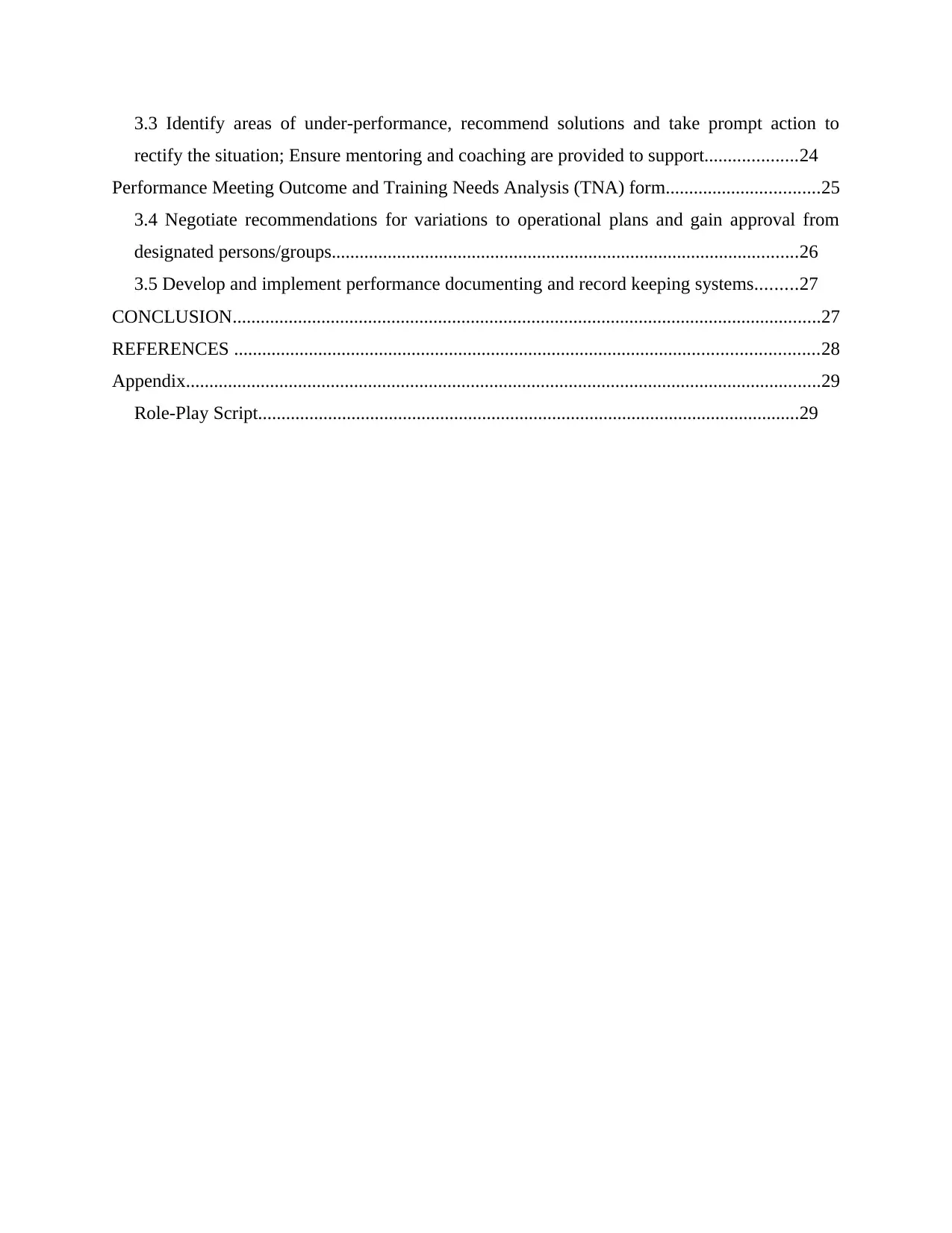
3.3 Identify areas of under-performance, recommend solutions and take prompt action to
rectify the situation; Ensure mentoring and coaching are provided to support....................24
Performance Meeting Outcome and Training Needs Analysis (TNA) form.................................25
3.4 Negotiate recommendations for variations to operational plans and gain approval from
designated persons/groups....................................................................................................26
3.5 Develop and implement performance documenting and record keeping systems.........27
CONCLUSION..............................................................................................................................27
REFERENCES .............................................................................................................................28
Appendix........................................................................................................................................29
Role-Play Script....................................................................................................................29
rectify the situation; Ensure mentoring and coaching are provided to support....................24
Performance Meeting Outcome and Training Needs Analysis (TNA) form.................................25
3.4 Negotiate recommendations for variations to operational plans and gain approval from
designated persons/groups....................................................................................................26
3.5 Develop and implement performance documenting and record keeping systems.........27
CONCLUSION..............................................................................................................................27
REFERENCES .............................................................................................................................28
Appendix........................................................................................................................................29
Role-Play Script....................................................................................................................29
⊘ This is a preview!⊘
Do you want full access?
Subscribe today to unlock all pages.

Trusted by 1+ million students worldwide
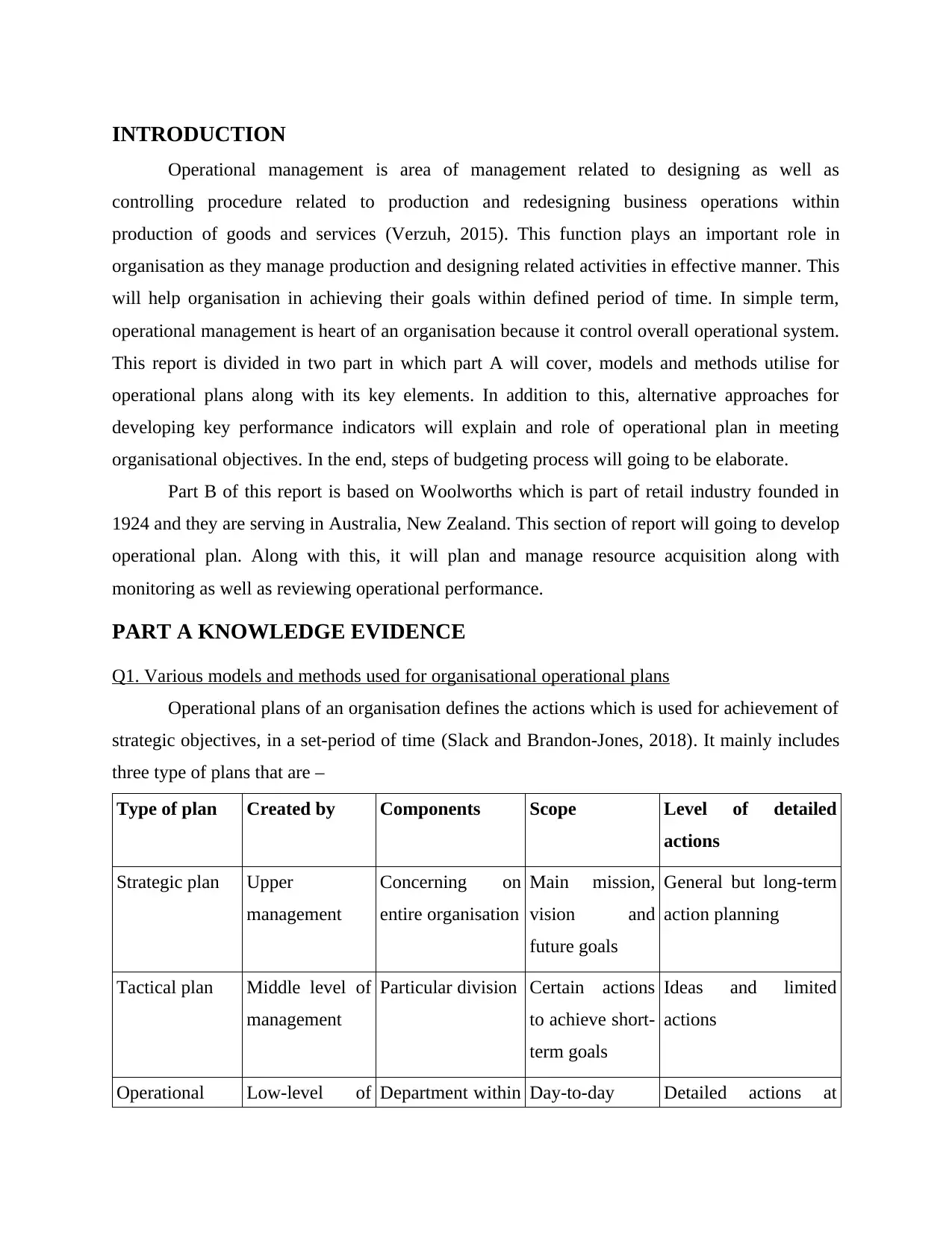
INTRODUCTION
Operational management is area of management related to designing as well as
controlling procedure related to production and redesigning business operations within
production of goods and services (Verzuh, 2015). This function plays an important role in
organisation as they manage production and designing related activities in effective manner. This
will help organisation in achieving their goals within defined period of time. In simple term,
operational management is heart of an organisation because it control overall operational system.
This report is divided in two part in which part A will cover, models and methods utilise for
operational plans along with its key elements. In addition to this, alternative approaches for
developing key performance indicators will explain and role of operational plan in meeting
organisational objectives. In the end, steps of budgeting process will going to be elaborate.
Part B of this report is based on Woolworths which is part of retail industry founded in
1924 and they are serving in Australia, New Zealand. This section of report will going to develop
operational plan. Along with this, it will plan and manage resource acquisition along with
monitoring as well as reviewing operational performance.
PART A KNOWLEDGE EVIDENCE
Q1. Various models and methods used for organisational operational plans
Operational plans of an organisation defines the actions which is used for achievement of
strategic objectives, in a set-period of time (Slack and Brandon-Jones, 2018). It mainly includes
three type of plans that are –
Type of plan Created by Components Scope Level of detailed
actions
Strategic plan Upper
management
Concerning on
entire organisation
Main mission,
vision and
future goals
General but long-term
action planning
Tactical plan Middle level of
management
Particular division Certain actions
to achieve short-
term goals
Ideas and limited
actions
Operational Low-level of Department within Day-to-day Detailed actions at
Operational management is area of management related to designing as well as
controlling procedure related to production and redesigning business operations within
production of goods and services (Verzuh, 2015). This function plays an important role in
organisation as they manage production and designing related activities in effective manner. This
will help organisation in achieving their goals within defined period of time. In simple term,
operational management is heart of an organisation because it control overall operational system.
This report is divided in two part in which part A will cover, models and methods utilise for
operational plans along with its key elements. In addition to this, alternative approaches for
developing key performance indicators will explain and role of operational plan in meeting
organisational objectives. In the end, steps of budgeting process will going to be elaborate.
Part B of this report is based on Woolworths which is part of retail industry founded in
1924 and they are serving in Australia, New Zealand. This section of report will going to develop
operational plan. Along with this, it will plan and manage resource acquisition along with
monitoring as well as reviewing operational performance.
PART A KNOWLEDGE EVIDENCE
Q1. Various models and methods used for organisational operational plans
Operational plans of an organisation defines the actions which is used for achievement of
strategic objectives, in a set-period of time (Slack and Brandon-Jones, 2018). It mainly includes
three type of plans that are –
Type of plan Created by Components Scope Level of detailed
actions
Strategic plan Upper
management
Concerning on
entire organisation
Main mission,
vision and
future goals
General but long-term
action planning
Tactical plan Middle level of
management
Particular division Certain actions
to achieve short-
term goals
Ideas and limited
actions
Operational Low-level of Department within Day-to-day Detailed actions at
Paraphrase This Document
Need a fresh take? Get an instant paraphrase of this document with our AI Paraphraser
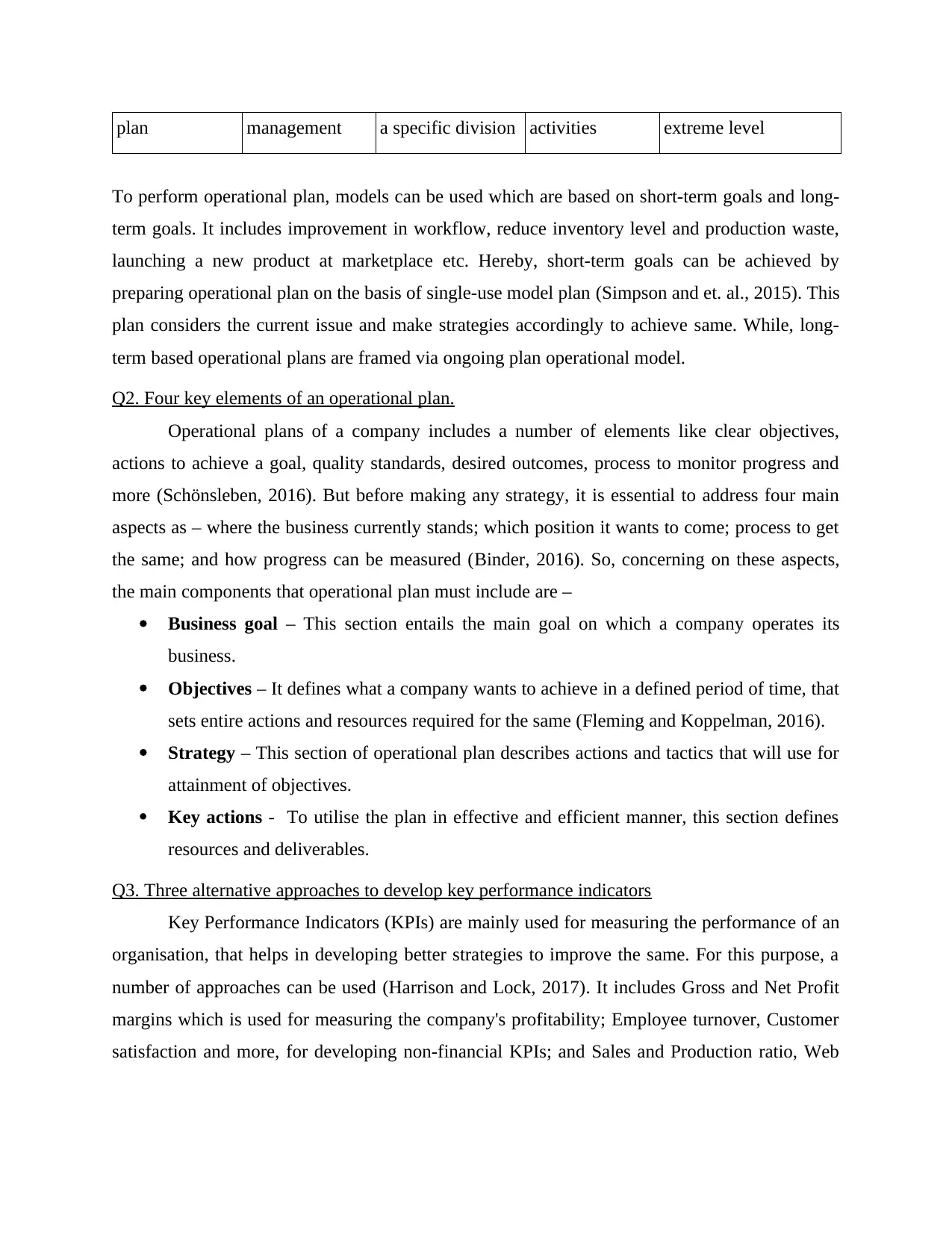
plan management a specific division activities extreme level
To perform operational plan, models can be used which are based on short-term goals and long-
term goals. It includes improvement in workflow, reduce inventory level and production waste,
launching a new product at marketplace etc. Hereby, short-term goals can be achieved by
preparing operational plan on the basis of single-use model plan (Simpson and et. al., 2015). This
plan considers the current issue and make strategies accordingly to achieve same. While, long-
term based operational plans are framed via ongoing plan operational model.
Q2. Four key elements of an operational plan.
Operational plans of a company includes a number of elements like clear objectives,
actions to achieve a goal, quality standards, desired outcomes, process to monitor progress and
more (Schönsleben, 2016). But before making any strategy, it is essential to address four main
aspects as – where the business currently stands; which position it wants to come; process to get
the same; and how progress can be measured (Binder, 2016). So, concerning on these aspects,
the main components that operational plan must include are –
Business goal – This section entails the main goal on which a company operates its
business.
Objectives – It defines what a company wants to achieve in a defined period of time, that
sets entire actions and resources required for the same (Fleming and Koppelman, 2016).
Strategy – This section of operational plan describes actions and tactics that will use for
attainment of objectives.
Key actions - To utilise the plan in effective and efficient manner, this section defines
resources and deliverables.
Q3. Three alternative approaches to develop key performance indicators
Key Performance Indicators (KPIs) are mainly used for measuring the performance of an
organisation, that helps in developing better strategies to improve the same. For this purpose, a
number of approaches can be used (Harrison and Lock, 2017). It includes Gross and Net Profit
margins which is used for measuring the company's profitability; Employee turnover, Customer
satisfaction and more, for developing non-financial KPIs; and Sales and Production ratio, Web
To perform operational plan, models can be used which are based on short-term goals and long-
term goals. It includes improvement in workflow, reduce inventory level and production waste,
launching a new product at marketplace etc. Hereby, short-term goals can be achieved by
preparing operational plan on the basis of single-use model plan (Simpson and et. al., 2015). This
plan considers the current issue and make strategies accordingly to achieve same. While, long-
term based operational plans are framed via ongoing plan operational model.
Q2. Four key elements of an operational plan.
Operational plans of a company includes a number of elements like clear objectives,
actions to achieve a goal, quality standards, desired outcomes, process to monitor progress and
more (Schönsleben, 2016). But before making any strategy, it is essential to address four main
aspects as – where the business currently stands; which position it wants to come; process to get
the same; and how progress can be measured (Binder, 2016). So, concerning on these aspects,
the main components that operational plan must include are –
Business goal – This section entails the main goal on which a company operates its
business.
Objectives – It defines what a company wants to achieve in a defined period of time, that
sets entire actions and resources required for the same (Fleming and Koppelman, 2016).
Strategy – This section of operational plan describes actions and tactics that will use for
attainment of objectives.
Key actions - To utilise the plan in effective and efficient manner, this section defines
resources and deliverables.
Q3. Three alternative approaches to develop key performance indicators
Key Performance Indicators (KPIs) are mainly used for measuring the performance of an
organisation, that helps in developing better strategies to improve the same. For this purpose, a
number of approaches can be used (Harrison and Lock, 2017). It includes Gross and Net Profit
margins which is used for measuring the company's profitability; Employee turnover, Customer
satisfaction and more, for developing non-financial KPIs; and Sales and Production ratio, Web
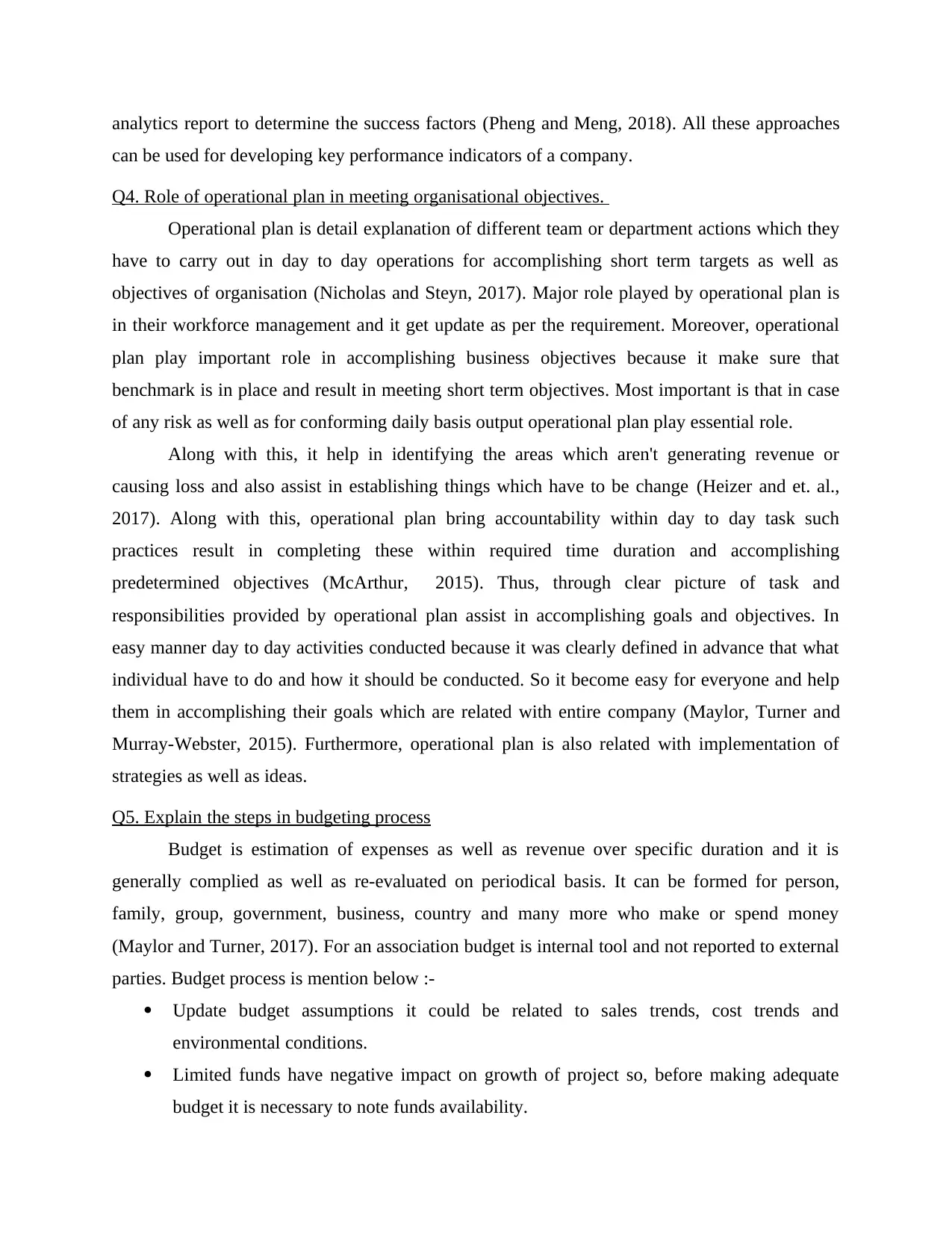
analytics report to determine the success factors (Pheng and Meng, 2018). All these approaches
can be used for developing key performance indicators of a company.
Q4. Role of operational plan in meeting organisational objectives.
Operational plan is detail explanation of different team or department actions which they
have to carry out in day to day operations for accomplishing short term targets as well as
objectives of organisation (Nicholas and Steyn, 2017). Major role played by operational plan is
in their workforce management and it get update as per the requirement. Moreover, operational
plan play important role in accomplishing business objectives because it make sure that
benchmark is in place and result in meeting short term objectives. Most important is that in case
of any risk as well as for conforming daily basis output operational plan play essential role.
Along with this, it help in identifying the areas which aren't generating revenue or
causing loss and also assist in establishing things which have to be change (Heizer and et. al.,
2017). Along with this, operational plan bring accountability within day to day task such
practices result in completing these within required time duration and accomplishing
predetermined objectives (McArthur, 2015). Thus, through clear picture of task and
responsibilities provided by operational plan assist in accomplishing goals and objectives. In
easy manner day to day activities conducted because it was clearly defined in advance that what
individual have to do and how it should be conducted. So it become easy for everyone and help
them in accomplishing their goals which are related with entire company (Maylor, Turner and
Murray-Webster, 2015). Furthermore, operational plan is also related with implementation of
strategies as well as ideas.
Q5. Explain the steps in budgeting process
Budget is estimation of expenses as well as revenue over specific duration and it is
generally complied as well as re-evaluated on periodical basis. It can be formed for person,
family, group, government, business, country and many more who make or spend money
(Maylor and Turner, 2017). For an association budget is internal tool and not reported to external
parties. Budget process is mention below :-
Update budget assumptions it could be related to sales trends, cost trends and
environmental conditions.
Limited funds have negative impact on growth of project so, before making adequate
budget it is necessary to note funds availability.
can be used for developing key performance indicators of a company.
Q4. Role of operational plan in meeting organisational objectives.
Operational plan is detail explanation of different team or department actions which they
have to carry out in day to day operations for accomplishing short term targets as well as
objectives of organisation (Nicholas and Steyn, 2017). Major role played by operational plan is
in their workforce management and it get update as per the requirement. Moreover, operational
plan play important role in accomplishing business objectives because it make sure that
benchmark is in place and result in meeting short term objectives. Most important is that in case
of any risk as well as for conforming daily basis output operational plan play essential role.
Along with this, it help in identifying the areas which aren't generating revenue or
causing loss and also assist in establishing things which have to be change (Heizer and et. al.,
2017). Along with this, operational plan bring accountability within day to day task such
practices result in completing these within required time duration and accomplishing
predetermined objectives (McArthur, 2015). Thus, through clear picture of task and
responsibilities provided by operational plan assist in accomplishing goals and objectives. In
easy manner day to day activities conducted because it was clearly defined in advance that what
individual have to do and how it should be conducted. So it become easy for everyone and help
them in accomplishing their goals which are related with entire company (Maylor, Turner and
Murray-Webster, 2015). Furthermore, operational plan is also related with implementation of
strategies as well as ideas.
Q5. Explain the steps in budgeting process
Budget is estimation of expenses as well as revenue over specific duration and it is
generally complied as well as re-evaluated on periodical basis. It can be formed for person,
family, group, government, business, country and many more who make or spend money
(Maylor and Turner, 2017). For an association budget is internal tool and not reported to external
parties. Budget process is mention below :-
Update budget assumptions it could be related to sales trends, cost trends and
environmental conditions.
Limited funds have negative impact on growth of project so, before making adequate
budget it is necessary to note funds availability.
⊘ This is a preview!⊘
Do you want full access?
Subscribe today to unlock all pages.

Trusted by 1+ million students worldwide
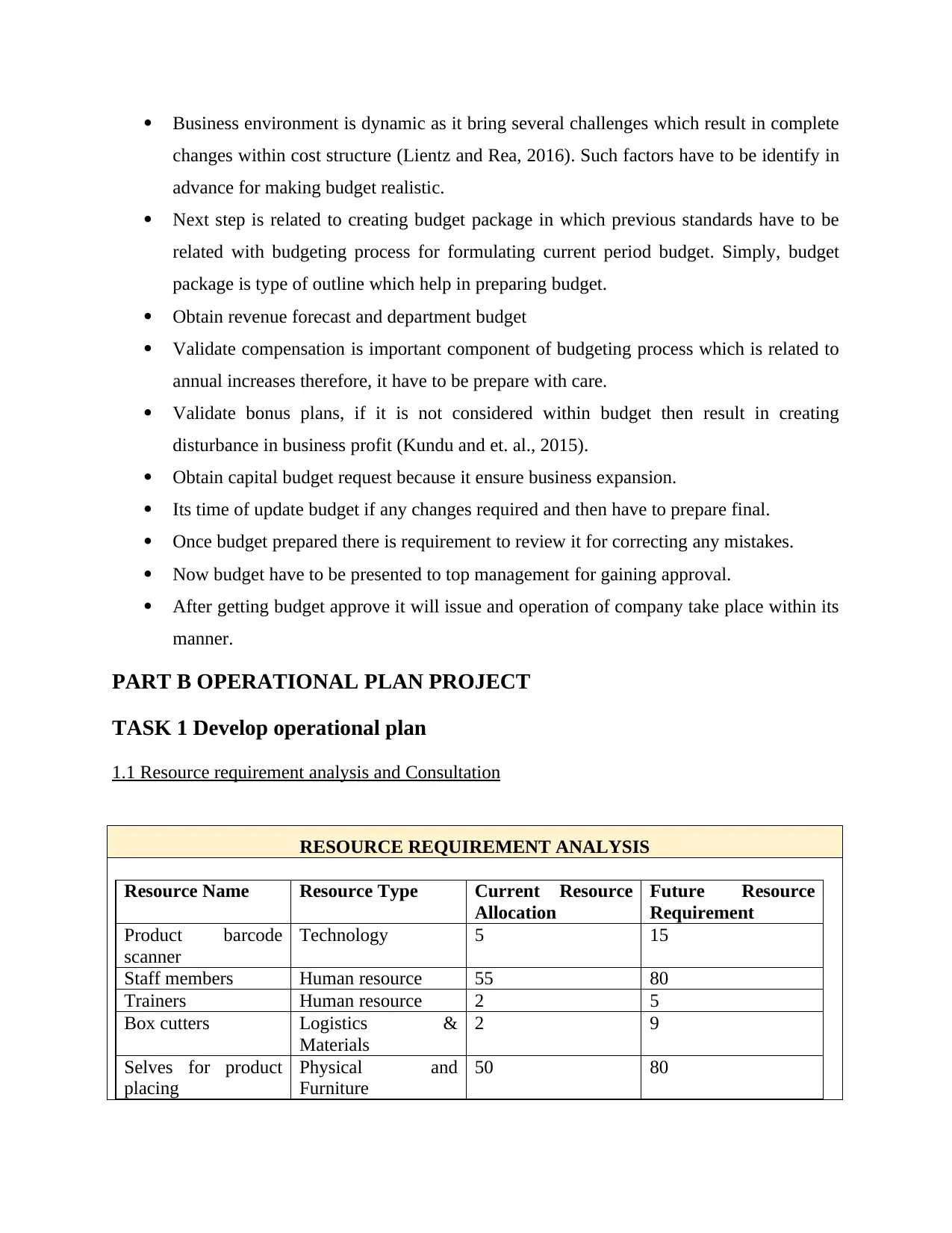
Business environment is dynamic as it bring several challenges which result in complete
changes within cost structure (Lientz and Rea, 2016). Such factors have to be identify in
advance for making budget realistic.
Next step is related to creating budget package in which previous standards have to be
related with budgeting process for formulating current period budget. Simply, budget
package is type of outline which help in preparing budget.
Obtain revenue forecast and department budget
Validate compensation is important component of budgeting process which is related to
annual increases therefore, it have to be prepare with care.
Validate bonus plans, if it is not considered within budget then result in creating
disturbance in business profit (Kundu and et. al., 2015).
Obtain capital budget request because it ensure business expansion.
Its time of update budget if any changes required and then have to prepare final.
Once budget prepared there is requirement to review it for correcting any mistakes.
Now budget have to be presented to top management for gaining approval.
After getting budget approve it will issue and operation of company take place within its
manner.
PART B OPERATIONAL PLAN PROJECT
TASK 1 Develop operational plan
1.1 Resource requirement analysis and Consultation
RESOURCE REQUIREMENT ANALYSIS
Resource Name Resource Type Current Resource
Allocation
Future Resource
Requirement
Product barcode
scanner
Technology 5 15
Staff members Human resource 55 80
Trainers Human resource 2 5
Box cutters Logistics &
Materials
2 9
Selves for product
placing
Physical and
Furniture
50 80
changes within cost structure (Lientz and Rea, 2016). Such factors have to be identify in
advance for making budget realistic.
Next step is related to creating budget package in which previous standards have to be
related with budgeting process for formulating current period budget. Simply, budget
package is type of outline which help in preparing budget.
Obtain revenue forecast and department budget
Validate compensation is important component of budgeting process which is related to
annual increases therefore, it have to be prepare with care.
Validate bonus plans, if it is not considered within budget then result in creating
disturbance in business profit (Kundu and et. al., 2015).
Obtain capital budget request because it ensure business expansion.
Its time of update budget if any changes required and then have to prepare final.
Once budget prepared there is requirement to review it for correcting any mistakes.
Now budget have to be presented to top management for gaining approval.
After getting budget approve it will issue and operation of company take place within its
manner.
PART B OPERATIONAL PLAN PROJECT
TASK 1 Develop operational plan
1.1 Resource requirement analysis and Consultation
RESOURCE REQUIREMENT ANALYSIS
Resource Name Resource Type Current Resource
Allocation
Future Resource
Requirement
Product barcode
scanner
Technology 5 15
Staff members Human resource 55 80
Trainers Human resource 2 5
Box cutters Logistics &
Materials
2 9
Selves for product
placing
Physical and
Furniture
50 80
Paraphrase This Document
Need a fresh take? Get an instant paraphrase of this document with our AI Paraphraser
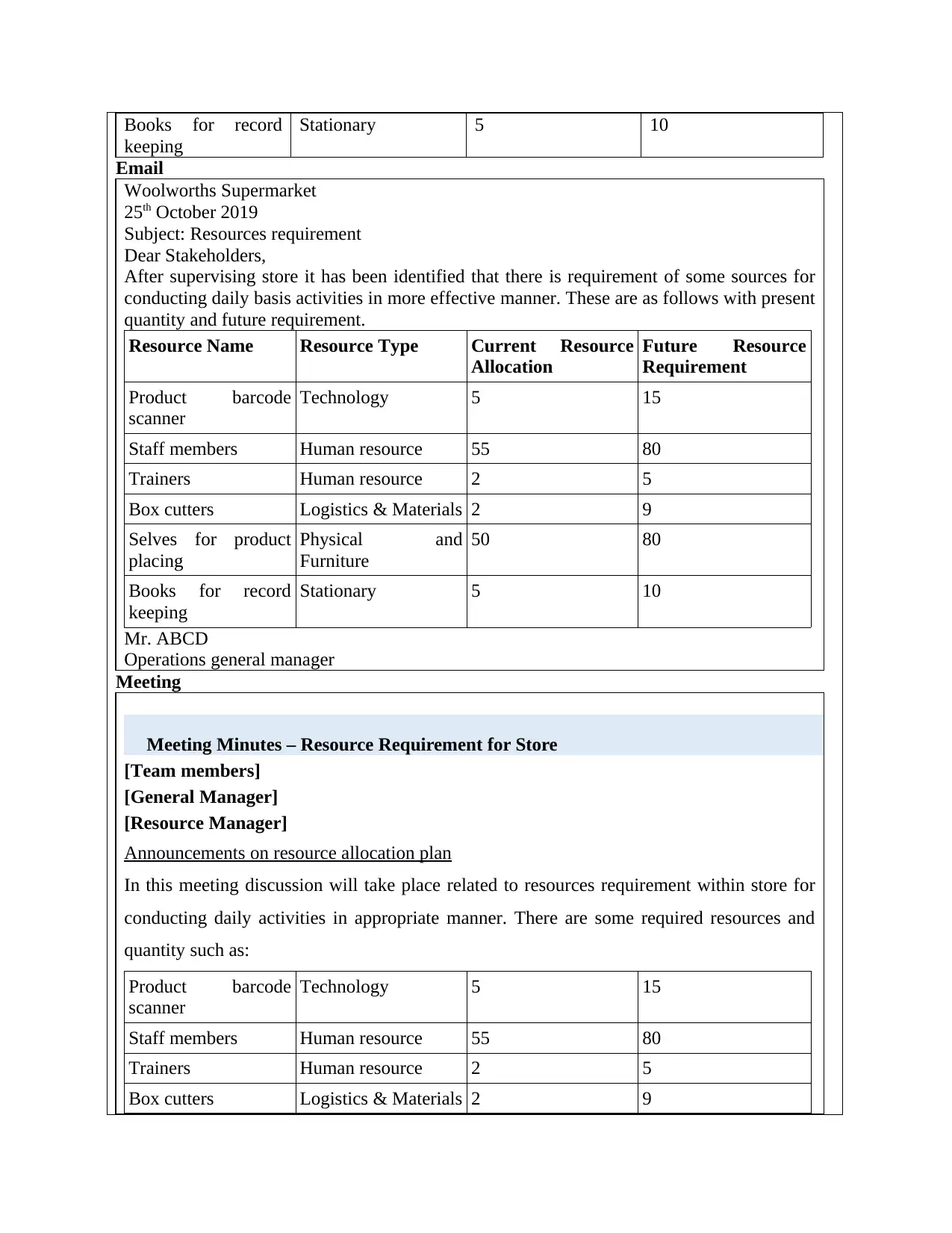
Books for record
keeping
Stationary 5 10
Email
Woolworths Supermarket
25th October 2019
Subject: Resources requirement
Dear Stakeholders,
After supervising store it has been identified that there is requirement of some sources for
conducting daily basis activities in more effective manner. These are as follows with present
quantity and future requirement.
Resource Name Resource Type Current Resource
Allocation
Future Resource
Requirement
Product barcode
scanner
Technology 5 15
Staff members Human resource 55 80
Trainers Human resource 2 5
Box cutters Logistics & Materials 2 9
Selves for product
placing
Physical and
Furniture
50 80
Books for record
keeping
Stationary 5 10
Mr. ABCD
Operations general manager
Meeting
Meeting Minutes – Resource Requirement for Store
[Team members]
[General Manager]
[Resource Manager]
Announcements on resource allocation plan
In this meeting discussion will take place related to resources requirement within store for
conducting daily activities in appropriate manner. There are some required resources and
quantity such as:
Product barcode
scanner
Technology 5 15
Staff members Human resource 55 80
Trainers Human resource 2 5
Box cutters Logistics & Materials 2 9
keeping
Stationary 5 10
Woolworths Supermarket
25th October 2019
Subject: Resources requirement
Dear Stakeholders,
After supervising store it has been identified that there is requirement of some sources for
conducting daily basis activities in more effective manner. These are as follows with present
quantity and future requirement.
Resource Name Resource Type Current Resource
Allocation
Future Resource
Requirement
Product barcode
scanner
Technology 5 15
Staff members Human resource 55 80
Trainers Human resource 2 5
Box cutters Logistics & Materials 2 9
Selves for product
placing
Physical and
Furniture
50 80
Books for record
keeping
Stationary 5 10
Mr. ABCD
Operations general manager
Meeting
Meeting Minutes – Resource Requirement for Store
[Team members]
[General Manager]
[Resource Manager]
Announcements on resource allocation plan
In this meeting discussion will take place related to resources requirement within store for
conducting daily activities in appropriate manner. There are some required resources and
quantity such as:
Product barcode
scanner
Technology 5 15
Staff members Human resource 55 80
Trainers Human resource 2 5
Box cutters Logistics & Materials 2 9
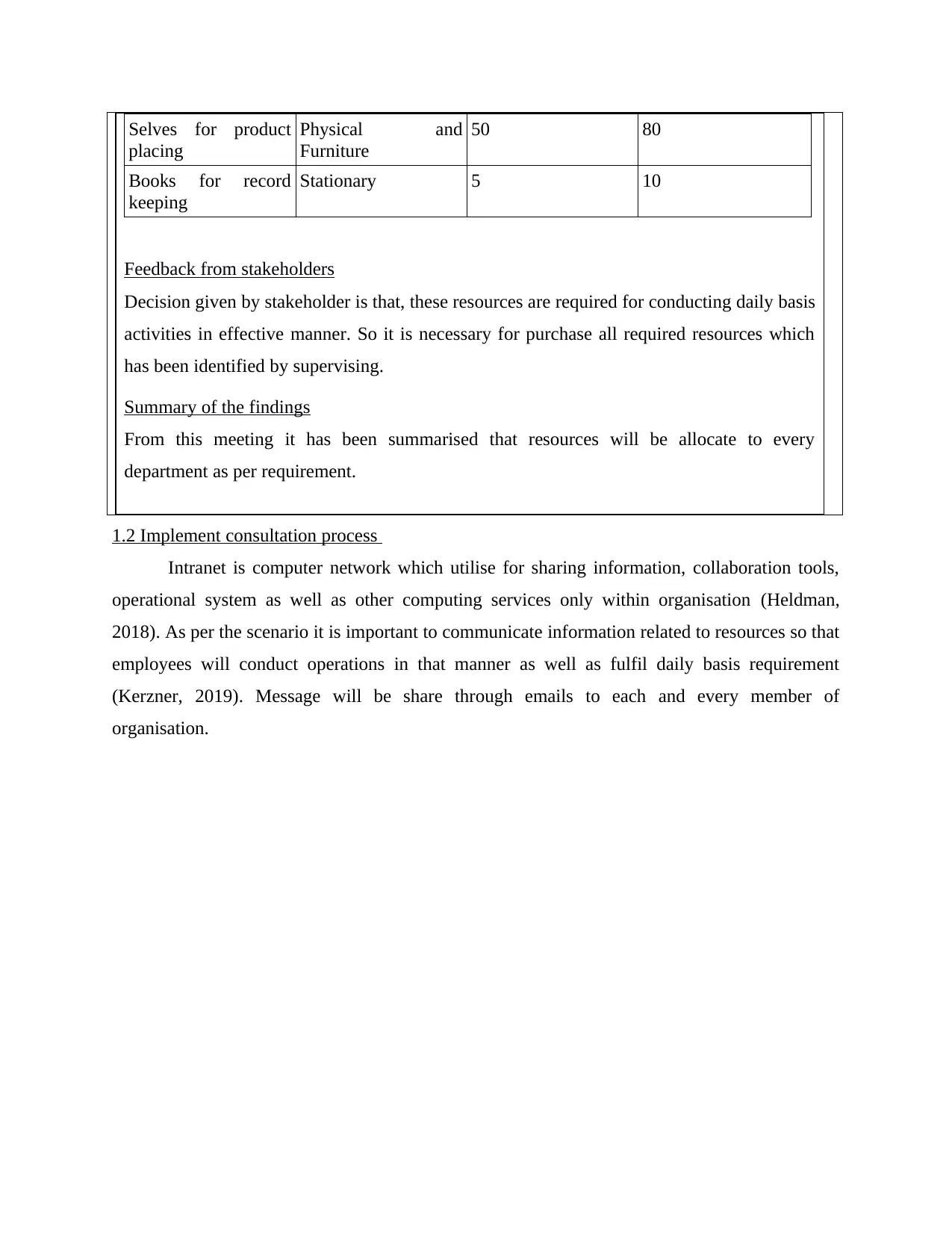
Selves for product
placing
Physical and
Furniture
50 80
Books for record
keeping
Stationary 5 10
Feedback from stakeholders
Decision given by stakeholder is that, these resources are required for conducting daily basis
activities in effective manner. So it is necessary for purchase all required resources which
has been identified by supervising.
Summary of the findings
From this meeting it has been summarised that resources will be allocate to every
department as per requirement.
1.2 Implement consultation process
Intranet is computer network which utilise for sharing information, collaboration tools,
operational system as well as other computing services only within organisation (Heldman,
2018). As per the scenario it is important to communicate information related to resources so that
employees will conduct operations in that manner as well as fulfil daily basis requirement
(Kerzner, 2019). Message will be share through emails to each and every member of
organisation.
placing
Physical and
Furniture
50 80
Books for record
keeping
Stationary 5 10
Feedback from stakeholders
Decision given by stakeholder is that, these resources are required for conducting daily basis
activities in effective manner. So it is necessary for purchase all required resources which
has been identified by supervising.
Summary of the findings
From this meeting it has been summarised that resources will be allocate to every
department as per requirement.
1.2 Implement consultation process
Intranet is computer network which utilise for sharing information, collaboration tools,
operational system as well as other computing services only within organisation (Heldman,
2018). As per the scenario it is important to communicate information related to resources so that
employees will conduct operations in that manner as well as fulfil daily basis requirement
(Kerzner, 2019). Message will be share through emails to each and every member of
organisation.
⊘ This is a preview!⊘
Do you want full access?
Subscribe today to unlock all pages.

Trusted by 1+ million students worldwide
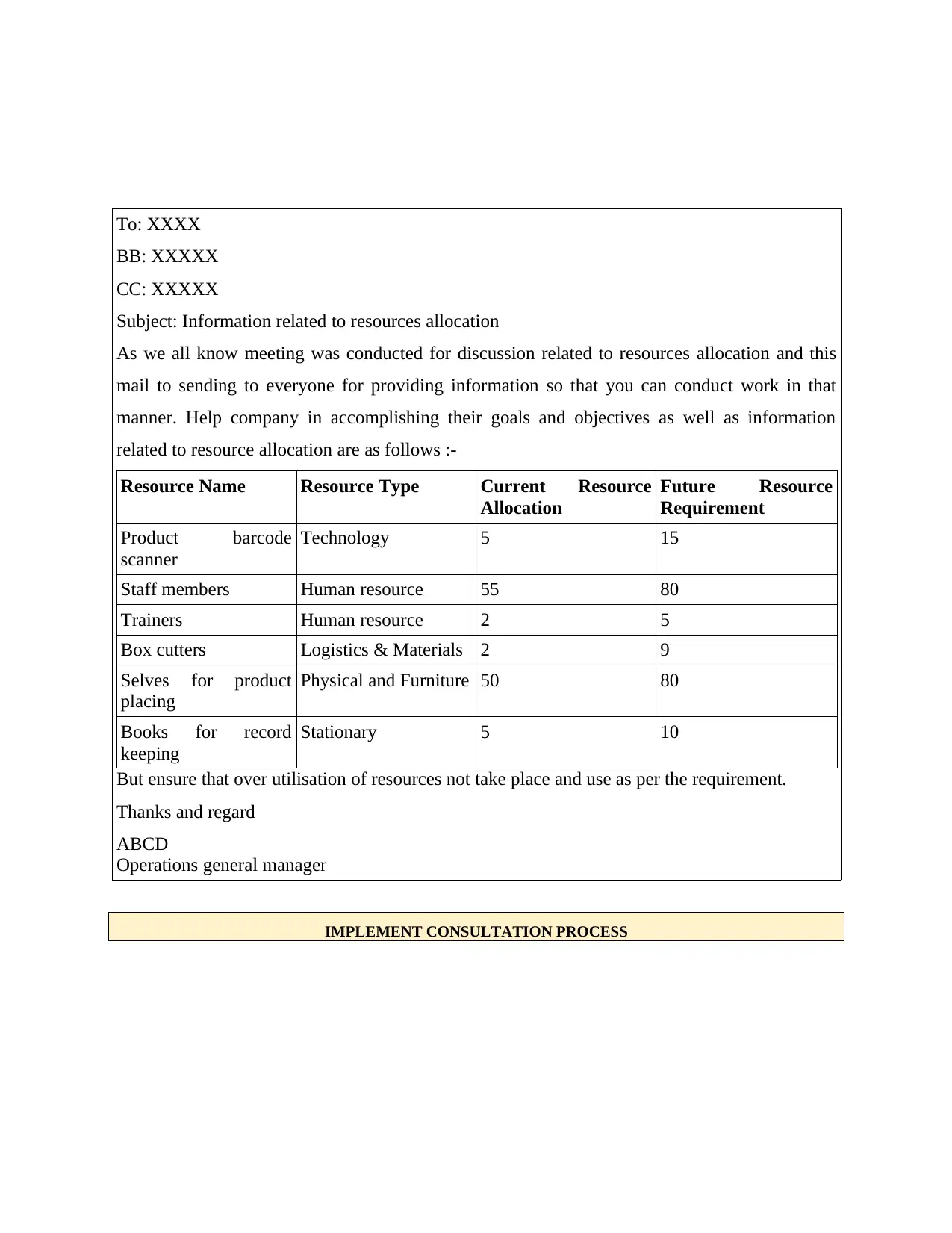
To: XXXX
BB: XXXXX
CC: XXXXX
Subject: Information related to resources allocation
As we all know meeting was conducted for discussion related to resources allocation and this
mail to sending to everyone for providing information so that you can conduct work in that
manner. Help company in accomplishing their goals and objectives as well as information
related to resource allocation are as follows :-
Resource Name Resource Type Current Resource
Allocation
Future Resource
Requirement
Product barcode
scanner
Technology 5 15
Staff members Human resource 55 80
Trainers Human resource 2 5
Box cutters Logistics & Materials 2 9
Selves for product
placing
Physical and Furniture 50 80
Books for record
keeping
Stationary 5 10
But ensure that over utilisation of resources not take place and use as per the requirement.
Thanks and regard
ABCD
Operations general manager
IMPLEMENT CONSULTATION PROCESS
BB: XXXXX
CC: XXXXX
Subject: Information related to resources allocation
As we all know meeting was conducted for discussion related to resources allocation and this
mail to sending to everyone for providing information so that you can conduct work in that
manner. Help company in accomplishing their goals and objectives as well as information
related to resource allocation are as follows :-
Resource Name Resource Type Current Resource
Allocation
Future Resource
Requirement
Product barcode
scanner
Technology 5 15
Staff members Human resource 55 80
Trainers Human resource 2 5
Box cutters Logistics & Materials 2 9
Selves for product
placing
Physical and Furniture 50 80
Books for record
keeping
Stationary 5 10
But ensure that over utilisation of resources not take place and use as per the requirement.
Thanks and regard
ABCD
Operations general manager
IMPLEMENT CONSULTATION PROCESS
Paraphrase This Document
Need a fresh take? Get an instant paraphrase of this document with our AI Paraphraser
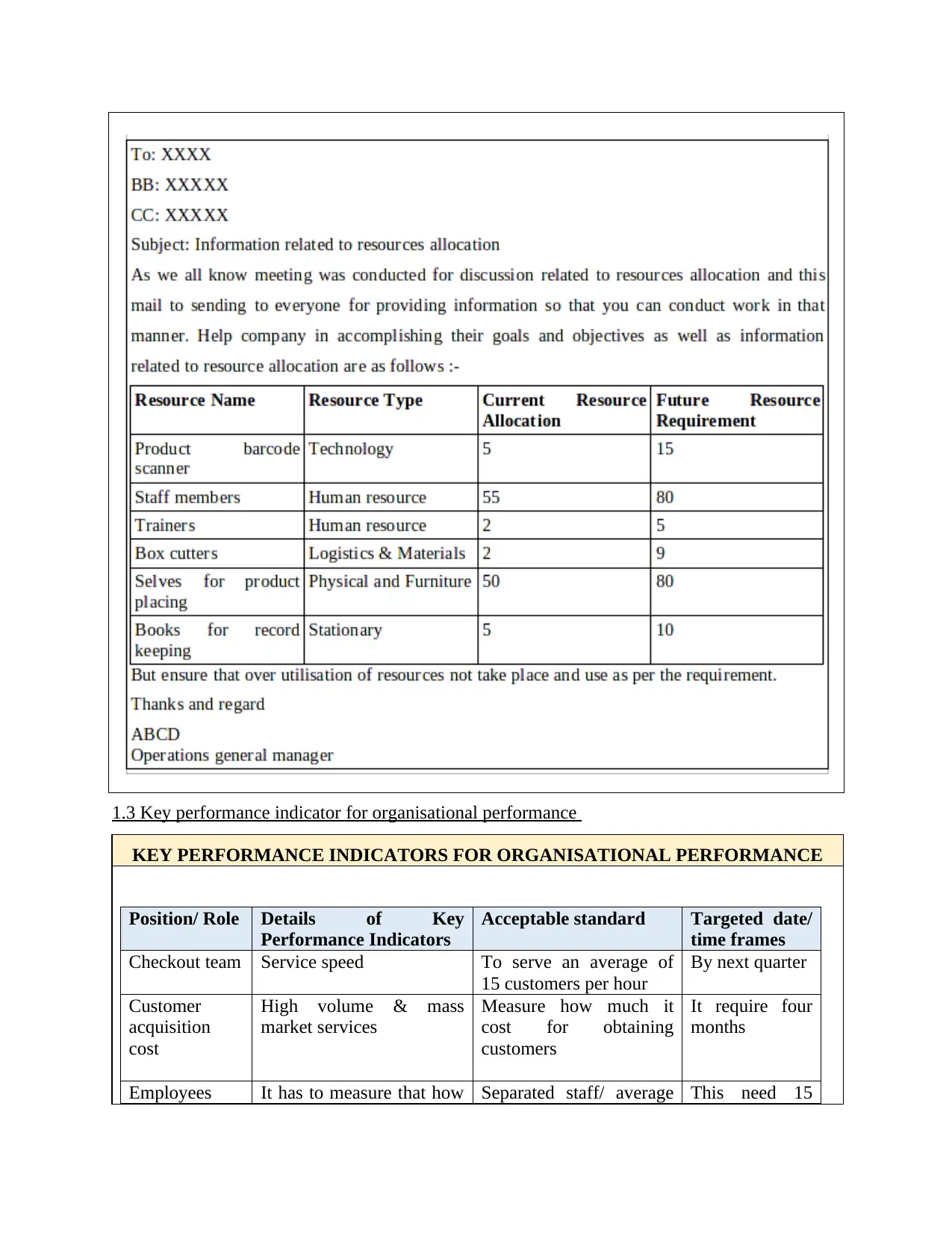
1.3 Key performance indicator for organisational performance
KEY PERFORMANCE INDICATORS FOR ORGANISATIONAL PERFORMANCE
Position/ Role Details of Key
Performance Indicators
Acceptable standard Targeted date/
time frames
Checkout team Service speed To serve an average of
15 customers per hour
By next quarter
Customer
acquisition
cost
High volume & mass
market services
Measure how much it
cost for obtaining
customers
It require four
months
Employees It has to measure that how Separated staff/ average This need 15
KEY PERFORMANCE INDICATORS FOR ORGANISATIONAL PERFORMANCE
Position/ Role Details of Key
Performance Indicators
Acceptable standard Targeted date/
time frames
Checkout team Service speed To serve an average of
15 customers per hour
By next quarter
Customer
acquisition
cost
High volume & mass
market services
Measure how much it
cost for obtaining
customers
It require four
months
Employees It has to measure that how Separated staff/ average This need 15
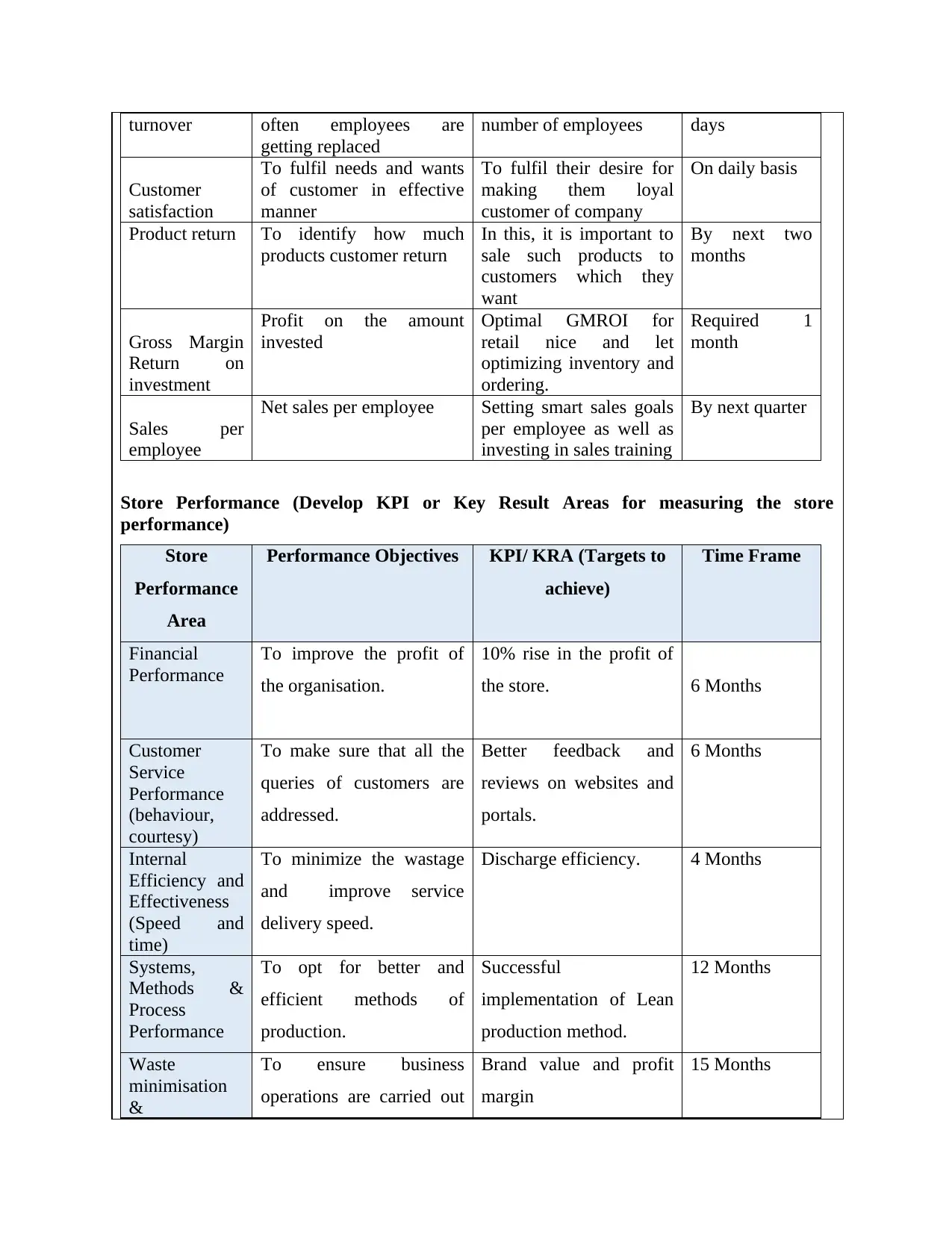
turnover often employees are
getting replaced
number of employees days
Customer
satisfaction
To fulfil needs and wants
of customer in effective
manner
To fulfil their desire for
making them loyal
customer of company
On daily basis
Product return To identify how much
products customer return
In this, it is important to
sale such products to
customers which they
want
By next two
months
Gross Margin
Return on
investment
Profit on the amount
invested
Optimal GMROI for
retail nice and let
optimizing inventory and
ordering.
Required 1
month
Sales per
employee
Net sales per employee Setting smart sales goals
per employee as well as
investing in sales training
By next quarter
Store Performance (Develop KPI or Key Result Areas for measuring the store
performance)
Store
Performance
Area
Performance Objectives KPI/ KRA (Targets to
achieve)
Time Frame
Financial
Performance
To improve the profit of
the organisation.
10% rise in the profit of
the store. 6 Months
Customer
Service
Performance
(behaviour,
courtesy)
To make sure that all the
queries of customers are
addressed.
Better feedback and
reviews on websites and
portals.
6 Months
Internal
Efficiency and
Effectiveness
(Speed and
time)
To minimize the wastage
and improve service
delivery speed.
Discharge efficiency. 4 Months
Systems,
Methods &
Process
Performance
To opt for better and
efficient methods of
production.
Successful
implementation of Lean
production method.
12 Months
Waste
minimisation
&
To ensure business
operations are carried out
Brand value and profit
margin
15 Months
getting replaced
number of employees days
Customer
satisfaction
To fulfil needs and wants
of customer in effective
manner
To fulfil their desire for
making them loyal
customer of company
On daily basis
Product return To identify how much
products customer return
In this, it is important to
sale such products to
customers which they
want
By next two
months
Gross Margin
Return on
investment
Profit on the amount
invested
Optimal GMROI for
retail nice and let
optimizing inventory and
ordering.
Required 1
month
Sales per
employee
Net sales per employee Setting smart sales goals
per employee as well as
investing in sales training
By next quarter
Store Performance (Develop KPI or Key Result Areas for measuring the store
performance)
Store
Performance
Area
Performance Objectives KPI/ KRA (Targets to
achieve)
Time Frame
Financial
Performance
To improve the profit of
the organisation.
10% rise in the profit of
the store. 6 Months
Customer
Service
Performance
(behaviour,
courtesy)
To make sure that all the
queries of customers are
addressed.
Better feedback and
reviews on websites and
portals.
6 Months
Internal
Efficiency and
Effectiveness
(Speed and
time)
To minimize the wastage
and improve service
delivery speed.
Discharge efficiency. 4 Months
Systems,
Methods &
Process
Performance
To opt for better and
efficient methods of
production.
Successful
implementation of Lean
production method.
12 Months
Waste
minimisation
&
To ensure business
operations are carried out
Brand value and profit
margin
15 Months
⊘ This is a preview!⊘
Do you want full access?
Subscribe today to unlock all pages.

Trusted by 1+ million students worldwide
1 out of 30
Related Documents
Your All-in-One AI-Powered Toolkit for Academic Success.
+13062052269
info@desklib.com
Available 24*7 on WhatsApp / Email
![[object Object]](/_next/static/media/star-bottom.7253800d.svg)
Unlock your academic potential
Copyright © 2020–2025 A2Z Services. All Rights Reserved. Developed and managed by ZUCOL.




